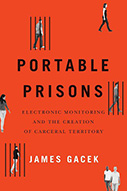Portable Prisons: Electronic Monitoring and the Creation of Carceral Territory

Author: James Gacek
Publisher: McGill-Queen’s University Press. 200 pages.
Reviewer: Gabriela Kirk ǀ June 2022
James Gacek’s book, Portable Prisons, fills a crucial gap in the academic study of electronic monitoring (EM) as a criminal legal tool and punishment. Drawing on literature and concepts across disciplines, Gacek provides a critical and detailed look at how EM operates in the lives of both the monitored and those who monitor. Gacek defines EM as a form of location monitoring that uses sensors to secure compliance within a specified routine of temporal and spatial locations sustained over a period of time. Gacek draws attention to the fact that EM is not just a form of home confinement, but also structures individuals’ movement and social relations within and outside of the home. The book makes important theoretical and empirical contributions to the fields of carceral geography, criminology, and the sociology of punishment. Gacek’s clear and engaging writing make this a great book for anyone new to the study of EM and carceral technologies.
Scholars have paid surprisingly little attention to ways in which EM changes the very nature of punishment despite it being a common sanction across Europe and the United States. Gacek’s contributions in this book begin to shed light on how we are not simply adding to the punishment toolkit in expanding EM, but also allowing the carceral to permeate everyday life in ways too often normalized. Focusing on the use of this sanction in Scotland, the book asks how both operators and offenders make sense of, feel, and manage the surveillance and confining nature of EM in their daily lives. Gacek pushes back on the idea that the use of EM represents a more rehabilitative or humanistic approach to punishment. By focusing on a country that prides itself on its progressive reform ideals, Gacek effectively questions and un-normalizes what he finds to be a highly restrictive and intrusive carceral practice.
One of the major contributions of the book is Gacek’s development of ‘carceral territory’ as a new concept and analytical tool to understand how EM operates. Gacek develops the concept by drawing on the emerging literature in geography on carcerality, space, and mobilities. He defines the concept as “the mechanisms that strategically inscribe penal logics on social relations outside the prison, via coordination and management of movement, time, and space” (p. 6). His study seeks to push this growing literature beyond thinking about the carceral as merely an extension of the prison, but also as reproduced in mundane everyday places. Rather than a simple transfer from one carceral space to another, Gacek describes carceral territory as strategic, relational, and processual. Carceral territory as a concept works to geographically contextualize EM as a form of punishment. Thus, EM is not just creating a prison in one’s home, but also structuring the personal lives, routines, and lifestyles of those monitored and their families.
In the second half of the book, Gacek draws on both ethnographic observations and interview data to explore his concept of carceral territory. The first empirical chapter describes Gacek’s experiences shadowing employees of the private company that contracts with the Scottish government to offer EM services. The inclusion of the perspective of EM officers is a particular strength of the book in that this group is often difficult to access and left out of scholarly work; they are, however, key to our understanding of power dynamics in this space. Interestingly, Gacek finds that these officers work under their own regimes of surveillance and that the monitoring center is itself a carceral territory. Gacek explores how monitoring officers collect and store personal information about those monitored, making those supervised knowable. Gacek also observed monitoring officers in action through ride-alongs where he describes how officers work to construct the home as a carceral territory.
One of Gacek’s most intriguing findings is that EM reconstructs individuals into self-governing individuals through a process of responsibilization. Rather than solely monitoring individuals externally through disembodied and anonymous supervision, EM also calls for self-monitoring which creates particular carceral subjectivities. Gacek shows how officers emphasize choice and responsibility when speaking to monitored individuals over the phone during check-ins. Gacek discusses how monitored individuals must make themselves knowable and locatable to officers to answer phone calls and how being able to respond to these calls also structures daily life in various ways. Self-surveillance is framed as a small price to pay for being able to remain in one’s home and with one’s family.
Gacek is frank and detailed about his struggles to obtain access to his site, providing helpful perspective for scholars and students engaging in this type of work. While the book claims to be partially focused on the role of privatized punishment, Gacek’s denial of access to the monitoring center by the Scottish government but permission by the private company raised questions for me as to whether we can think of EM as truly privatized punishment. The government appears to maintain the final say and control over these spaces. While Gacek does not make this argument himself, this point seems to suggest that we should more carefully consider in what ways EM represents the state’s efforts to privatize justice or not. His own struggles in data collection highlight the difficulty in parsing out the public from the private in today’s criminal legal systems.
Finally, Gacek discusses his findings from interviews with individuals supervised via EM. In this chapter, Gacek discusses how EM creates its own forms of penal waiting, the risks of stigmatization, and the ways in which EM has become palatable for monitored individuals. Gacek makes the point that his respondents perceive EM to be palatable because it has been packaged to be so, not that it is inherently so. I was struck by the casual nature in which Gacek’s respondents described their experience with EM as unsurprising and quotidian. I would have liked to have seen a deeper analysis of this finding. What were his respondents’ expectations about the punishment process? In what ways has the experience of being subjected to EM been normalized for them? Additionally, Gacek doesn’t return to the theme of responsibilization in this portion of the book so we are left not knowing how supervised individuals experience this process.
Overall, Gacek spends a significant portion of the book discussing theory and the literature, but I was left wanting more empirical details and a deeper discussion of his findings. Given the difficulty of gaining access to the field site, which Gacek discusses, I was disappointed to see how little time Gacek spent in the field. In total, he only spent a few shifts with the officers and only interviewed 10 monitored individuals. While the quantity of qualitative data does not determine its richness, more time in the field may have resulted in a deeper analysis of Gacek’s findings. Gacek’s incredible access to the officers during ride-alongs provides an often-unattainable glimpse into these processes. I would have liked to have learned more about how officers thought about their positionality, how they considered their jobs, and a greater discussion of Gacek’s observations of interactions between officers and monitored individuals.
Despite my desire for more empirical detail, Gacek concludes that his primary goal in the book is to develop the idea of carceral territory to help us better understand how people, punishment, and places are connected. Scotland’s use of EM is primarily through curfew monitoring, so it may not appear at first to be as confining as traditional incarceration. Gacek argues that EM does more than simply move the prison to the home; it also inscribes and dictates supervisees’ social relations in their communities. One of the key contributions of the concept of carceral territory is its relational aspect. However, I didn’t feel that Gacek fully addressed this idea in his empirical data. Although Gacek discusses how families were impacted by the back-and-forth nature that violations of EM caused, I was left wanting to know more about how the experience of EM itself impacted relations within the home and within their communities.
All in all, Gacek’s book is much needed to increase scholarly attention to the sanction of EM and similar technologies. Carceral and surveillance technologies are growing at a rapid pace worldwide, motivated by powerful private interests. In places like Scotland, these technologies have taken on an air of progressive reform that may not be warranted. Gacek writes to a scholarly audience who he hopes comes away with an appreciation for defining and naming the complex social, relational, and geographic dynamics integral to this type of surveillance experience. He also writes to a wider public who he hopes pauses to consider the implications of normalizing the expansion of carceral technologies. Gacek calls us as citizens to be unsettled by the ways in which we have normalized this surveillance and allowed it to expand and become routine.
Gabriela Kirk, PhD Candidate, Department of Sociology, Northwestern University


